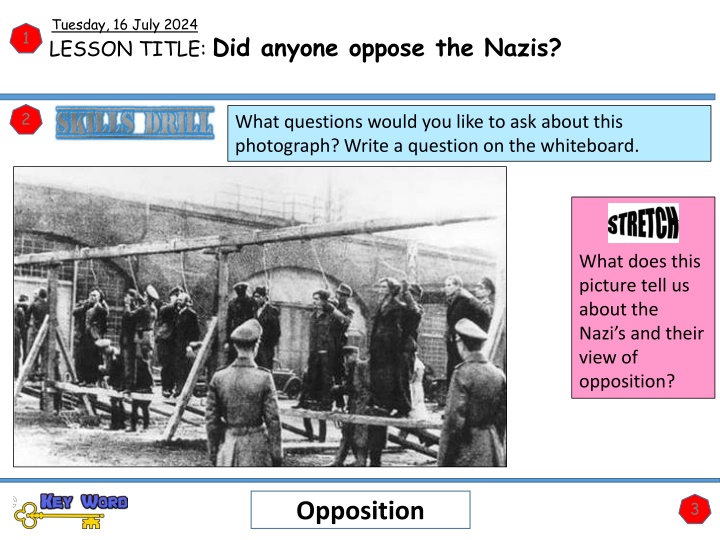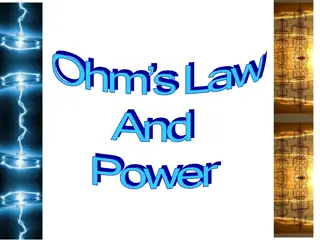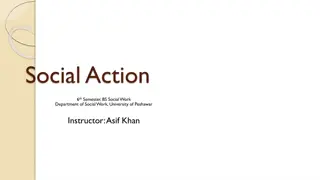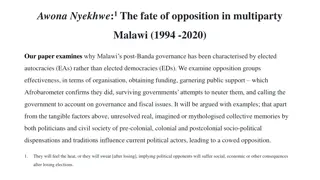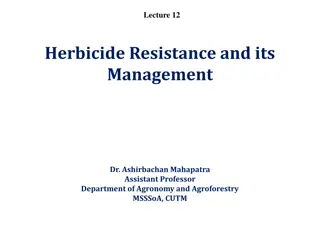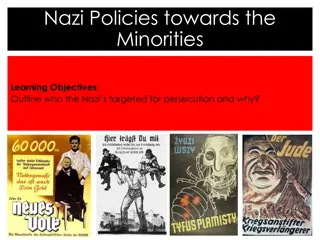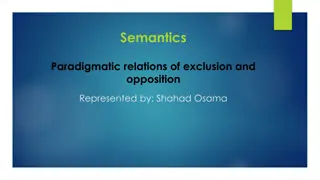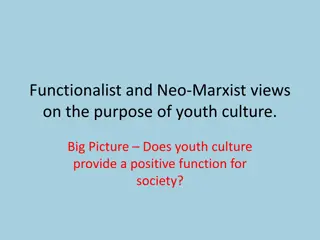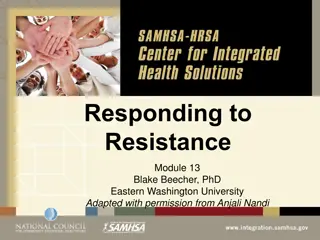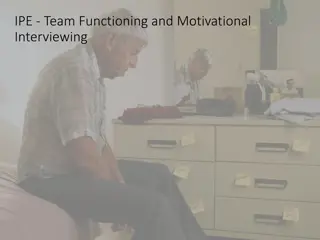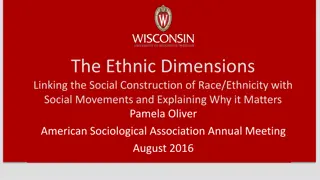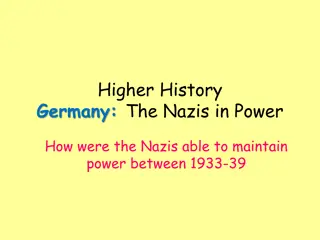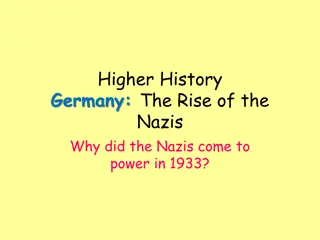Opposition to Nazis: Youth Groups and Resistance Movements
Explore various forms of opposition to the Nazis through youth groups like the Swing Youth and Edelweiss Pirates. Learn about their defiance against the Nazi regime, including activities and methods of resistance. Discover the diversity of opposition movements and their impact on Nazi Germany's control.
Download Presentation

Please find below an Image/Link to download the presentation.
The content on the website is provided AS IS for your information and personal use only. It may not be sold, licensed, or shared on other websites without obtaining consent from the author.If you encounter any issues during the download, it is possible that the publisher has removed the file from their server.
You are allowed to download the files provided on this website for personal or commercial use, subject to the condition that they are used lawfully. All files are the property of their respective owners.
The content on the website is provided AS IS for your information and personal use only. It may not be sold, licensed, or shared on other websites without obtaining consent from the author.
E N D
Presentation Transcript
Tuesday, 16 July 2024 LESSON TITLE: Did anyone oppose the Nazis? 1 2 What questions would you like to ask about this photograph? Write a question on the whiteboard. What does this picture tell us about the Nazi s and their view of opposition? 3 Opposition
Did anyone oppose the Nazis? To assess how significant was the threat of opposition. Mastering Securing Explain how people opposed the Nazi s. To describe the different groups/people who opposed the Nazis. Developing
Das Gestapo Treffen. You need to gather intelligence on other opposition groups using reports by your fellow officers on slides 5-9. You don t have long before you must depart and capture enemies of the Fuhrer! Complete the table as you go to get as much intelligence as possible.
Gestapo Report Name of opposition Why did they oppose the Nazis? Methods of opposition How much of a threat? Youth Groups Swing Youth Youth Groups Edelweiss Pirates The Church - Catholic The Church - Protestant Martin Niemoller
Youth Groups Youth Groups The Swing Youth The Swing Youth A group made up of predominantly middle class young people. They took part in activities that were frowned upon by the Nazis. Because they were from wealthier families, they could afford record players and played records that had been illegally imported from America. A group made up of predominantly middle class young people. They took part in activities that were frowned upon by the Nazis. Because they were from wealthier families, they could afford record players and played records that had been illegally imported from America. These young people loved swing music, which was hated by the Nazi government who classed it as non- German and as developed by black people and Jews. They would gather together, usually drink alcohol and smoke, to listen and dance in groups. They began to organise illegal dances, which could be attended by up to 6000 young people. These young people loved swing music, which was hated by the Nazi government who classed it as non- German and as developed by black people and Jews. They would gather together, usually drink alcohol and smoke, to listen and dance in groups. They began to organise illegal dances, which could be attended by up to 6000 young people. Although many young people joined the Hitler Youth, it was not popular with everyone. By the mid-1930s gangs began to appear on street corners. They played their own music and boys and girls were free to be together. Sometimes, they went looking for members of the Hitler Youth and beat them up. Although many young people joined the Hitler Youth, it was not popular with everyone. By the mid-1930s gangs began to appear on street corners. They played their own music and boys and girls were free to be together. Sometimes, they went looking for members of the Hitler Youth and beat them up. The Edelweiss Pirates The Edelweiss Pirates The Edelweiss Pirates was a mostly working class youth group who opposed the Nazi regime. It wasn t one big organisation but a collection of groups. Local areas had their versions or branches. For example, in Cologne they were called the Navajos, Dusseldorf had the Kittelback Pirates and Essen had the Roving Dudes. Numbers varied, but it was popular and in large cities might have had several hundred members. The Edelweiss Pirates was a mostly working class youth group who opposed the Nazi regime. It wasn t one big organisation but a collection of groups. Local areas had their versions or branches. For example, in Cologne they were called the Navajos, Dusseldorf had the Kittelback Pirates and Essen had the Roving Dudes. Numbers varied, but it was popular and in large cities might have had several hundred members. They used passive resistance to oppose the Nazis. They refused to join the Hitler Youth, and when this became compulsory they avoided meetings at all costs. They wanted to have fun and do what they wanted not what they were told. They used passive resistance to oppose the Nazis. They refused to join the Hitler Youth, and when this became compulsory they avoided meetings at all costs. They wanted to have fun and do what they wanted not what they were told. They engaged in various activities to oppose the Nazis including making up rude alternatives to the pro-Nazi songs sung by the Hitler Youth, drinking, listening to banned music ( degenerate jazz and blues ), having sex and going to dances. Some even beat up Nazi Youth members. Their unofficial uniform was a checked shirt and wearing badges showing the edelweiss flower (a white Alpine flower which became a symbol of resistance for some) They engaged in various activities to oppose the Nazis including making up rude alternatives to the pro-Nazi songs sung by the Hitler Youth, drinking, listening to banned music ( degenerate jazz and blues ), having sex and going to dances. Some even beat up Nazi Youth members. Their unofficial uniform was a checked shirt and wearing badges showing the edelweiss flower (a white Alpine flower which became a symbol of resistance for some)
Were youth groups a threat? Were youth groups a threat? Up to 1939, the opposition of the Edelwiess Pirates and the Swing Youth to the Nazis was limited. Up to 1939, the opposition of the Edelwiess Pirates and the Swing Youth to the Nazis was limited. Their actions were limited. Resisted Nazi expectations but up until 1939, they did little else but occasionally daubing anti-Nazi graffiti on walls, telling anti-Nazi jokes and attacking Hitler Youth members. Their actions were limited. Resisted Nazi expectations but up until 1939, they did little else but occasionally daubing anti-Nazi graffiti on walls, telling anti-Nazi jokes and attacking Hitler Youth members. Their motives were limited. Their opposition was mainly cultural concerned with clothes, music and behaviour, rather than political opposition. Their motives were limited. Their opposition was mainly cultural concerned with clothes, music and behaviour, rather than political opposition. Their numbers were limited. By 1939, membership of the Edelweiss Pirates was about 2000, at the same time Hitler Youth membership was at about 8 million. Their numbers were limited. By 1939, membership of the Edelweiss Pirates was about 2000, at the same time Hitler Youth membership was at about 8 million. The existence of these alternative youth groups shows that a minority of German youths were unconvinced by Nazi control and expections. They defied those expectations. However, it cannot be said that embers of these groups were typical of German youth. They were not the kind of opposition to the Nazis that posed a threat to Hitler s Germany. The existence of these alternative youth groups shows that a minority of German youths were unconvinced by Nazi control and expections. They defied those expectations. However, it cannot be said that embers of these groups were typical of German youth. They were not the kind of opposition to the Nazis that posed a threat to Hitler s Germany.
The Church The Church The Catholic Church The Catholic Church Some Catholic priests spoke out against Nazi ideas and policies. Around 400 Catholic priests were eventually imprisoned in the priests block at Dachau concentration camp. Some Catholic priests spoke out against Nazi ideas and policies. Around 400 Catholic priests were eventually imprisoned in the priests block at Dachau concentration camp. Despite the Concordat with the Catholic Church there was tension after 1933 because the Nazis censored the Catholic press and harassed priests. In 1937, Pope Pius XI issued a letter titled With burning anxiety , that criticised the Nazi system. Priests read the letter to their congregations, clearly showing they were trying to resist Nazi attempts to control the church. However, the Nazi reaction was to take an even firmer line and close Catholic groups and prevent catholics from joining the Nazi Party. Despite the Concordat with the Catholic Church there was tension after 1933 because the Nazis censored the Catholic press and harassed priests. In 1937, Pope Pius XI issued a letter titled With burning anxiety , that criticised the Nazi system. Priests read the letter to their congregations, clearly showing they were trying to resist Nazi attempts to control the church. However, the Nazi reaction was to take an even firmer line and close Catholic groups and prevent catholics from joining the Nazi Party. The Protestant Church The Protestant Church In 1933 a group of Protestant pastors (including Martin Niemoller) set up the Pastors Emergency League (PEL). They opposed 2 key aspects of Nazi control: The joining of regional churches into one national German Christian Church. Nazi attempts to stop Jews becoming Christians and to ban the Jewish Old Testament from Christian teaching. By 1934, the PEL had 7000 members. However, many pastors left when they were persecuted by the Nazis. In 1933 a group of Protestant pastors (including Martin Niemoller) set up the Pastors Emergency League (PEL). They opposed 2 key aspects of Nazi control: 1. The joining of regional churches into one national German Christian Church. 2. Nazi attempts to stop Jews becoming Christians and to ban the Jewish Old Testament from Christian teaching. By 1934, the PEL had 7000 members. However, many pastors left when they were persecuted by the Nazis. In 1934 the PEL set up the Confessing Church. This meant there were 2 Protestant churches in Germany. The Reich Church, which accepted Nazi interference and the Confessing Church, which opposed Nazi interference. In 1934 the PEL set up the Confessing Church. This meant there were 2 Protestant churches in Germany. The Reich Church, which accepted Nazi interference and the Confessing Church, which opposed Nazi interference. Were they a threat? Were they a threat? The opposition of church leaders was limited. Some Germans attending church services in defiance of the Nazis and some publicly applauded Church leaders who opposed the Nazis. These are examples of a refusal to conform - a kind of resistance to the Nazis. But there were few Christians who were brave, or foolish, enough to oppose the Nazis openly. The opposition of church leaders was limited. Some Germans attending church services in defiance of the Nazis and some publicly applauded Church leaders who opposed the Nazis. These are examples of a refusal to conform - a kind of resistance to the Nazis. But there were few Christians who were brave, or foolish, enough to oppose the Nazis openly.
Martin Niemoller Martin Niemoller Martin Niemoller was a First World war hero (U-boat captain). He was a right wing supporter, and was even a member of the Freikorps after the war. He began to openly oppose the Nazis from the 1930s. Martin Niemoller was a First World war hero (U-boat captain). He was a right wing supporter, and was even a member of the Freikorps after the war. He began to openly oppose the Nazis from the 1930s. Not many Christian ministers opposed the Nazi persecution of the Jews, and only 50 ministers (out of 17,000) were arrested for opposition activities or speeches. Many ministers had sworn an oath of loyalty to the Fuhrer after he set up the Reich church. Many however, refused. Niemoller helped set up an alternative the Confessional Church and began to speak out against the Nazis. Not many Christian ministers opposed the Nazi persecution of the Jews, and only 50 ministers (out of 17,000) were arrested for opposition activities or speeches. Many ministers had sworn an oath of loyalty to the Fuhrer after he set up the Reich church. Many however, refused. Niemoller helped set up an alternative the Confessional Church and began to speak out against the Nazis. In his sermons he spoke out against the arrest of Christian ministers, and the Nazi changes to the Christian church. He did not however, speak out against Hitler s political ideas or policies, in fact he admitted that Hitler s anti-Semitism was a more extreme version of his own prejudices. He was arrested in 1937 and sent to Dachau concentration camp. He was due to be executed, however he was freed by the Allies shortly before the end of WW2. In his sermons he spoke out against the arrest of Christian ministers, and the Nazi changes to the Christian church. He did not however, speak out against Hitler s political ideas or policies, in fact he admitted that Hitler s anti-Semitism was a more extreme version of his own prejudices. He was arrested in 1937 and sent to Dachau concentration camp. He was due to be executed, however he was freed by the Allies shortly before the end of WW2.
There is no sheet for this exercise, but create your own diamond 4 with the information you ve collected. This was the most significant threat to the Nazis because . You need to decide which was the most significant threat to the Nazis. The most significant threat, you need to place at the top and explain why this was the case. Likewise you need to explain why the others were a threat but maybe not as significant. This was a threat to the Nazis because . But it was not as significant as . Looking at the different threats you ve studied. How do you think the Nazis could deal with these in the most effective way?
How significant was the threat to the Nazis? Write a tweet (no more than 280 characters long) explaining how significant you think the Nazis were threatened.
